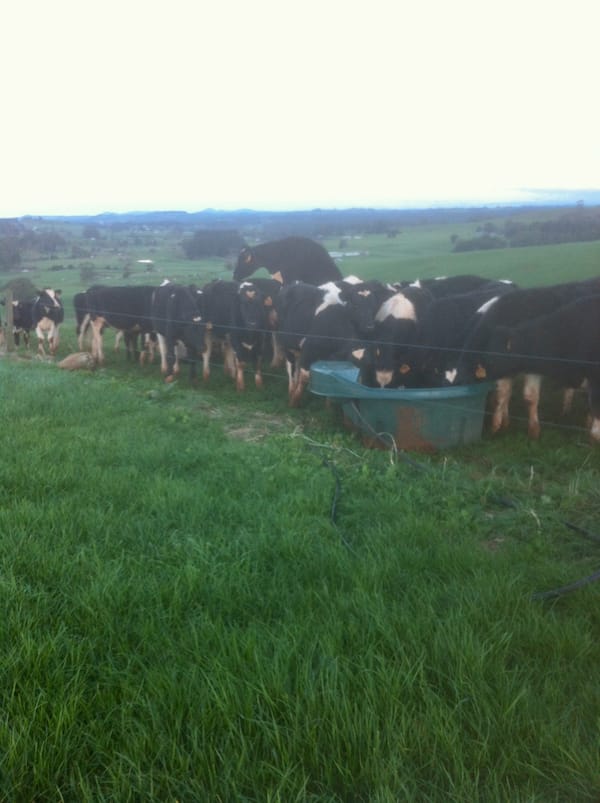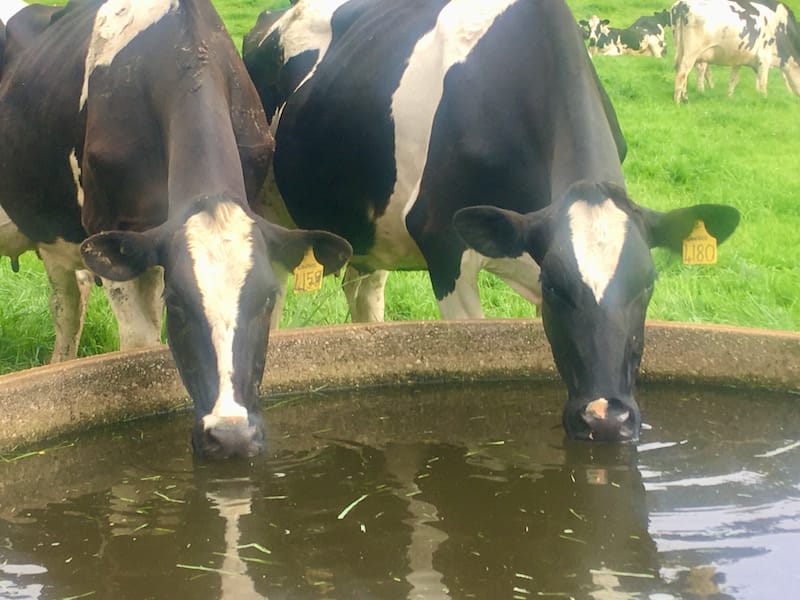We all know how important it is to hydrate.
And, while you may have your water needs all figured out, when you’re following a rotational grazing system, it could be a lot more difficult to make sure that water is easily accessible at all the paddocks you go through within the grazing system.
If you have a plan, you won’t be in a jam! I’m here to tell you all about providing water for your cattle in a rotational grazing system and give you some easy-peasy tips that will ensure that your cows are always hydrated.
Why all the fuss about water?
Water is one of the most essential nutrients that cattle need. But it’s also one of the resources that’s most overlooked and completely taken for granted. It’s used in almost every bodily function right from digestion to milk production and excretion.
Your cows must have easy access to water in every paddock that’s in the perimeter of your rotational grazing system for maximum efficiency.
The advantages of clean water are as follows:
- Cows can consumer more dry matter
- There is an increase in average daily gains
- Milk production is increased
- The likelihood of illness and diseases are decreased
- Grazing is more efficient
- Manure is distributed more evenly
On the other hand, what happens when there is not enough water?
- Dry matter intake is reduced
- Average daily gains are reduced
- There are more chances of cows going through heat stress
- Cows could have serious illnesses due to algal blooms and other water pollutants
- Manure is not evenly distributed throughout the pasture
- Grazing is inefficient
Water is one of the most important resources needed for your cattle but sometimes, we tend to take it for granted. We focus a lot on high-quality forage or winter feed and water takes a backseat.

An optimized rotational grazing system should be done in such a way that
- Your cows won’t need to travel more than 800 feet for water
- If your cattle are likely to access water as a group, at least 5% - 15% of the group should be able to access the water at the same time
- If you consider a circular tank, every animal should have 20 inches of space and if you take a straight tank, every animal should have 30 inches.
Apart from providing enough space so that your cows aren't jostling against each other, you also need to ensure that your water supply is good.
Ensure that your water supply rate and storage is always more than what your animals need. That way, you'll make sure that the more submissive and non-demanding cows also get access to enough water, even after the bossy cows have had their fill!

Access to water in every paddock that’s a part of your rotational grazing system is a must. Every paddock should have some sort of water supply.
The first thing to be done is to assess the infrastructure and see if additional troughs/pipes are needed. You could always draw them out on maps to see how they fit into the overall framework.
Don’t forget to calculate your flow rate to ensure adequate supply. The larger troughs should be able to compensate for any low flow rates during periods of high water demand.
Ideal flow rate
The ideal flow rate differs according to what kind of pumps are used, or the size of the pipes.
Here's some information to help you include troughs in your fields:
- Water intake of 10 – 15 litres per 100 kg body weight per day
- The capacity of troughs to be at 5 – 7 litres per livestock unit
- Cows don’t like to walk more than 250 meters to drink up
Troughs
Troughs can be fitted with long water pipes so that the troughs can be moved from one paddock to another, easily.
Another option is to use mobile water carriers which are also easy to move and connect. The mobile carriers should be able to hold enough water according to the requirement of your cows.
Do remember that some equipment cannot be used from main supplies since there could be a backflow of contaminated water unless a non-return valve is installed.
Single-hole, automatic watering fountain
This type is suitable when animals tend to drink together, at one time. If the herd is relatively small, at a size that’s either 20 cows or less and the pasture is less than 10 acres and the cattle don’t have to travel distances for water, this is a good choice!
Most of these approaches work well for summer but there is a risk of frost during winter seasons. Speaking of which, let’s chat a bit about water in winter, shall we?
Water availability during winter:
During winter, as the distance to the water gets farther and farther away, your cows will switch to chomping on snow as their main source of water. You will still need one snow-proof source of water when there is no clean snow or for when there is no snow and only ice.
Tips on how to create a frost-proof water site:
Site Drainage:
Your water site needs to be built on high-ground or on a gravel pad/well-drained soils so that the area around the site doesn’t get waterlogged. And if you’re using a concrete pad, make sure that the pad is surrounded by gravel that is on the same level as the concrete pad.
A concrete pad that is just surrounded by deep mud and nothing else could cause foot injuries in your cows which would then lure bacteria and cause diseases and infections like foot rot.
Level access:
As slopes turn into ice, it gets quite slippery. And this is why level access to water is so important so that your cows don’t slip and slide on the ice.
Many graziers would opt for natural and direct access to creeks and ponds during winter. However, these otherwise harmless spots during summer turn into evil cow-traps during winter and have been known to cause serious injuries and aborted fetuses.
Accidentally falling into water isn’t as fun as it seems and could cause a major drain on their energy levels.
If you feel that you need to continue using open water, you can maintain the approach path with gravel all through the winter.
The other (and better) alternative is to gravity-feed water into a trough on level ground with the excess water piped back into the stream. This way, the water that’s continuously piped back will help keep the trough from freezing over.
Livestock water checklist:
Below is the list of important points to consider when you’re planning water supply for your cattle:
- Calculate flow rates accurately based on variables like pressure, pipe diameter and friction losses
- Determine the best trough sizes for your rotational grazing program
- Choose the best pumping method and also provide for pumping options when there is no power
- Decide whether you need a mobile water trough or a permanent water site that your cows can access through water alleys
- Build the best approaches to natural water
- Install on-site water storage systems to boost the flow rates and meet the high demand
- Prepare for seasons of drought well in advance
Some fun facts:
Studies have shown that given a choice, cattle prefer to drink from a water trough 92 per cent of the time, and a stream only 8 per cent of the time!
This works well for us because other studies have shown that luring cattle away from streams reduces fecal streptococci bacteria in the water by 77 per cent, nitrogen by 54 per cent, phosphorous by 81 per cent and total suspended solids by 90 per cent!
Research in Wyoming concluded that 77 per cent of grazing occurred within 1200 feet of the source of water.
Remember how we told you earlier on that water sources should be at a distance of 800 feet or less? Well, this is because when cows travel more than 900 feet to drink, they travel as a herd.
Kind of like how ladies always prefer to go to the restroom together! Anyway, when they travel as a herd, there’s too much demand on the water tank.
Studies have shown an increase in milk output in cows.

From natural water sources like streams and ponds to troughs, tanks and different kinds of pumping systems, there are a whole host of options you can pick to make sure your cows get their fill of earth juice!
If this article interested you, we are growing a decent repository on this sort of information, which you can check here on pasture grazing management.
Until we meet again, Happy Farming!
- The Dedicated Team of Pasture.io, 2020-11-04